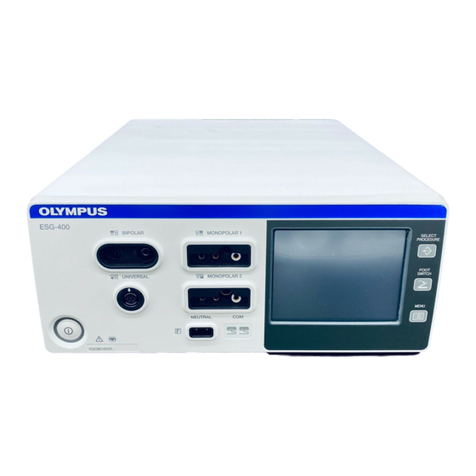
CelonLab
ENT
EN Instructions for Use
4
W7098046
1. Safety and Warnings
Warning: The safety and effectiveness of electrosurgical
interventions depend not only on the design of the equipment used,
ut also to a major extent on factors which are under the control of
the user. It is therefore extremely important to read, understand and
follow the instructions supplied with the coagulation electrodes, the
power control unit and the accessories in order to ensure safety and
effectiveness.
Caution: The safety of electrosurgery ill be greatly enhanced by a thorough
kno ledge of the medical literature on the subject. Study of specific
information on the hazards and complications of the procedure in question is
especially recommended.
Caution: The CelonLab
ENT
po er control unit may only be used ith
compatible coagulation electrodes and accessories. The electrodes must be
designed for the maximum peak output voltage. (see Technical Data).
Caution: Before use, the electrosurgical unit and accessories must be
examined for damage. Cables and accessories ith damaged insulation or
connections must not be used.
Caution: Wherever possible, the patient should not be able to come into
contact ith electrically conductive components that are earthed. Route all
connecting cables, in particular the cables to the coagulation electrodes, so
that they are not in direct contact ith the patient or other cables.
Warning: The high frequency equipment, when applied to a patient
with a cardiac pacemaker, an implanted cardioverter defi rillator
(ICD) or other implanted electronic devices (IED), may cause
malfunctioning or failure of the implanted electronic device and may
seriously affect the patient. Always confirm that it is safe to proceed
with a cardiologist or the manufacturer of the implanted electronic
device efore proceeding. If monopolar modes of the electrosurgical
generator are used, position the neutral electrode so that the current
pathway does not pass through or near the implanted electronic
device and its lead system. The risk of malfunction or failure of an
implanted electronic device is reduced y the use of a ipolar mode.
A risk does exist, however, if the application is in close proximity to
the implanted electronic device.
Warning: The risk of flamma le gases or other materials eing
ignited exists with any surgical application of electrical energy.
Precautionary measures must e taken to keep flamma le materials
and su stances away from the site of intervention (do not use
flamma le anaesthetics, nitrous oxide or oxygen). Flamma le agents
used for cleaning and disinfection must e allowed to evaporate
efore the electrosurgical unit is used.
Caution: Electrodes and probes of monitoring, stimulation and imaging
devices can conduct radiofrequency currents. Electrodes and probes (e.g. ECG
and EEG) must be kept as far a ay as possible from the site of the
electrosurgical intervention. Needle monitoring electrodes should not be used,
as they may cause patient burns. Physiological monitoring equipment
incorporating high frequency current limiting devices is recommended.




























